Animal control deals with problems on dogs of all breeds. Sometimes smaller dogs, such as poodles and chihuahuas have a bit of a Napoleon complex and can be the most vicious. In general, certain dogs are known for their specific qualities. For example, German Shepherds are regarded for their intelligence, Labradors for their sense of smell and St. Bernards for their size. One notorious breed known for its violent tendencies is the Pitbull. Amid having sharp teeth and a jaw that locks once it sinks into a target, the dogs are also known as a notorious menace. Is this menace true? Is the Pitbull more likely to bite than other breeds? Here you will learn surprising U.S. statistics on dog bites and much more.
Table of Contents
- A Quick Glance At Dog Bite Statistics in The United States
- Pit Bull Bite Statistics
- U.S. Statistics on Dog Bites & Deaths of other Breeds
- What are the Safest Dog Breeds?
- Training for Safety
- Potentially Dangerous Dog Breeds
- Common Characteristics of Dangerous Breeds
- SUMMARY OF U.S. STATISTICS ON DOG BITES BY BREED
- Pit Bulls – 3,397 attacks and 295 deaths
- Rottweiler – 535 attacks and 8 deaths
- German Shepherd – 113 attacks and 15 kills
- Presa Canario – 111 attacks and 18 deaths
- Hybrid Wolfdog – 85 attacks and 19 kills
- Siberian Husky – 83 attacks and 26 kills
- Akita – 70 attacks and 8 deaths
- Boxer – 64 attacks and 7 kills
- Chow Chow – 61 attacks and 8 deaths
- Labrador Retriever – 56 attacks and 3 deaths
- Australian Shepherd – 38 attacks and 1 death
- Great Dane – 37 attacks and 3 kills
- Mastiff – 28 attacks and 5 deaths
- Doberman – 23 attacks and 8 kills
- Cane Corso – 21 attacks and 2 deaths
- English Bulldog – 20 attacks and 1 kill
- Alaskan Malamute – 15 attacks and 6 kills
- St. Bernards – 12 attacks and 1 kill
- Golden Retriever – 11 attacks and 3 kills
- FINAL THOUGHTS/CONCLUSION
- Read Next: 20 Most Dangerous Dogs in the World
A Quick Glance At Dog Bite Statistics in The United States
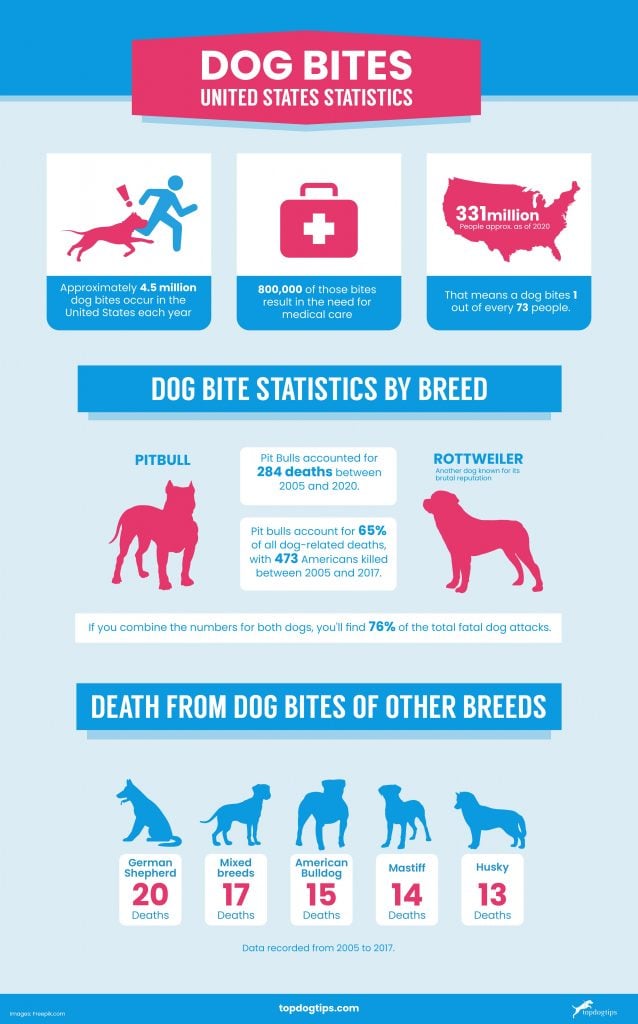
Pit Bull Bite Statistics
According to a study from the Center For Disease Control (CDC), approximately 4.5 million dog bites occur in the United States each year, and 800,000 of those bites result in the need for medical care. The U.S. population is approximately 331 million people as of 2020. That means a dog bites 1 out of every 73 people. There are alarming figures. Yet anxiety becomes much less when the right information is available to you.
To understand the overall U.S. statistics on dog bites, it is best to start with the Pitbull. No dog has a more egregious reputation, but are these fears clouded in myth or reality? Let's look at the statistical period from 2005 to 2020. According to Canine Journal, an organization that collects and analyzes all dog bite attacks in the country, Pit Bulls accounted for 284 deaths in those years. That's a staggering 65% of all dog-related deaths, with 473 Americans killed between 2005 and 2017.
Another dog known for its brutal reputation is the Rottweiler. If you combine the numbers for both dogs, you'll find 76% of the total fatal dog attacks. These numbers may seem shocking, but they might say something more. Instead of arguing that Pit Bulls bite more, you could argue that they are more efficient once they attack. Whereas a bite from a smaller dog may not be fatal.
U.S. Statistics on Dog Bites & Deaths of other Breeds
Let's look at some other statistics as we rank the dog breeds most likely to bite or attack according to the data. The German Shepherd produced 20 deaths in total while mixed breeds accounted for 17 deaths. Another massive dog, the American Bulldog produced 15 deaths and is known to dislike strange company. Mastiffs, known for their use as a guard dog, killed 14 people. Rounding out the list of the most dangerous dog breeds is the Husky with 13 deaths recorded from 2005 to 2017.
Speaking of wolves, the wolf dog hybrid breed can be very dangerous. These animals pose a threat because they are more of a wild animal than a domesticated friend, even under the best guidance of a trained master. The Husky-wolf hybrid can be extremely unpredictable. This dog is often sought after for its majesty, but if unqualified or untrained, Huskies will be very aggressive. This is not a deterrent, as Huskies are among the most intelligent of breeds. It is simply that owners do not give them the attention they deserve. German Shepards are the third most likely breed of dog to attack. However, their mortality statistics are more a result of helping humans then harming them. As mentioned above, Rottweilers and Pit Bulls are the second and first most dangerous breeds.
According to Canine Journal, as of 2016 there were an estimated 78 million dogs in the United States. Of those, we saw 4.5 million dog bites, 19% of which resulted in injury. A total of $530,000,000,000 in insurance claims for dog bite-related injuries.
What are the Safest Dog Breeds?
Statistically speaking, there are two breeds of dogs that are known for their safety. Golden Retrievers and Labrador Retrievers are the breeds least likely to bite or inflict harm on a human. Keep in mind that these dogs are used for hunting. Their soft teeth are not intended to penetrate the birds they catch. By that logic, their teeth would barely penetrate human skin. Bird dogs understand that their bite is not to be fatal, so they almost never even try unless indicated by danger. Retrievers are also among the friendliest and most sociable breeds for human companionship and work-related associations.
Training for Safety
Given that some of the most dangerous dogs, statistically speaking, are also among the most popular breeds for domestication, one question may arise in the minds of pet owners. That is: how can one make sure their dog doesn't bite? The battle will begin when the dog is still a puppy. Vigilant dog owners will make sure he disappears, chews and nibbles on items. When the dog tries to sink his teeth in, one should withdraw his hand and yelp in pain. This will teach the dog that his bite is dangerous to his safety. It is also important that your dog socializes with other dogs and human friends on a regular basis. The more company expected, the less dangerous the dog will be. Let him see that most humans do not harm him. Also, keep the dog active in healthy exercise throughout his upbringing. Accumulated aggression can get the dog (and its owner) into trouble later on. If all else fails, one should call a professional dog trainer to set proper limitations for their furry friend.
Potentially Dangerous Dog Breeds
According to the law approved by the BOE in 2002, these are the breeds of potentially dangerous dogs and for which you need a license if you want to adopt them:
- Pit Bull Terrier
- Staffordshire Bull Terrier
- American Staffordshire Terrier
- Rottweiler
- Dogo Argentino
- Fila Brasileiro
- Tosa Inu
- Akita Inu
Common Characteristics of Dangerous Breeds
- Strong musculature, powerful appearance, robust, athletic configuration, agility, vigor and endurance.
- Marked character and great courage.
- Short hair
- Thoracic perimeter between 60 and 80 centimeters, height and width between 50 and 70 centimeters and weight over 20 kg.
- Voluminous head, cuboid, robust, with broad and large skull and muscular and bulging cheeks. Large and strong jaws, robust, wide and deep mouth.
- Wide, muscular and short neck.
- Chest solid, broad, large, deep, arched ribs and short muscular back.
- Parallel, straight and robust forelegs and very muscular hindquarters, with relatively long legs forming a moderate angle.
SUMMARY OF U.S. STATISTICS ON DOG BITES BY BREED
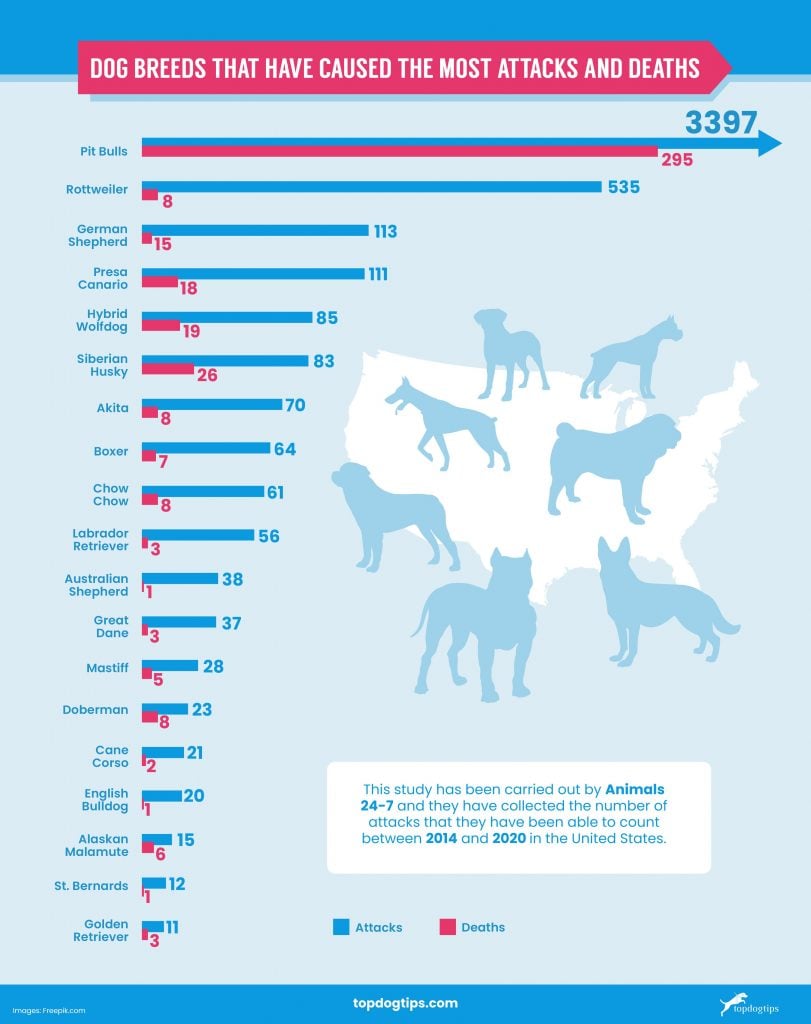
Dog breeds that have caused the most attacks and deaths. This study has been carried out by Animals 24-7 and they have collected the number of attacks that they have been able to count between 2014 and 2020 in the United States.
We must keep in mind that, of the number of attacks that occur, few lead to serious incidents. In fact, the vast majority of attacks are produced by small dogs, but the consequences are not serious and do not transcend.
However, let's see the ones that have transcended because they have produced from very serious injuries to the death of people, I repeat, in more than 30 years (this statistic also includes crossbreeds when referring to pure breeds):

Pit Bulls – 3,397 attacks and 295 deaths
It appears on the PPP (Perros Potencialmente Peligrosos i.e Potentially Dangerous Dogs) list, it is the most feared breed and, unfortunately, with the most bad reputation. The statistics do not lie, they are there, however, those of us who love dogs know that the animal is not to blame.
Pit Bulls account for 6% of dogs in the United States. What is most striking about their attacks is that they attack children and adults alike when, in general, attacks on children are more common because they do not know how to treat dogs or how to read the warning signs. Another striking feature of the attacks is that many of the attacks are unannounced, with no warning signs.
Thus, Pit bulls should be adopted by people very experienced in the care and education of this type of breed.

Rottweiler – 535 attacks and 8 deaths
Rottweiler also appears on the PDD list. It follows a more common attack pattern: its attacks are mostly aimed at children who have not respected the animal and have not known how to read the warning signs too. The problem with serious and fatal wounds is that being such powerful dogs with so much strength, they do not know how to calculate the force of the bite. However, their intention is never to kill.
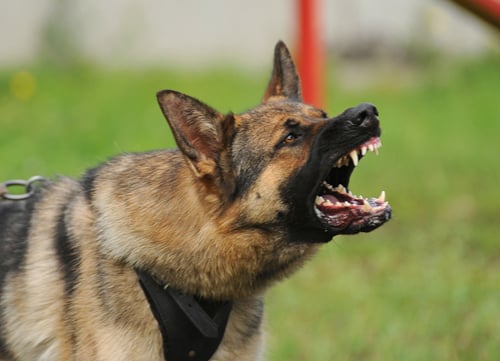
German Shepherd – 113 attacks and 15 kills
They do not appear as PDD and have a very good reputation, especially because they are excellent police assistants. Their protective character often leads them to hurt, with serious consequences, but never with the intention of doing so. We must not forget that they are guard dogs, they need to have their “flock” under control and not knowing how to read their language can lead to unfortunate incidents.
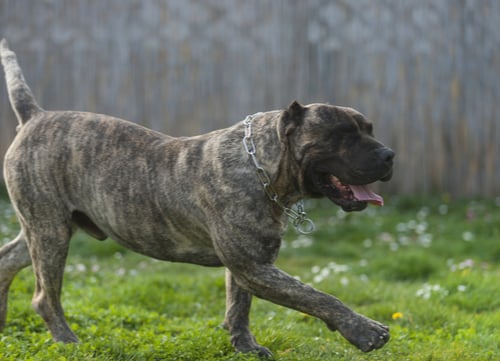
Presa Canario – 111 attacks and 18 deaths
Not listed as PDD, the Presa Canario, shares with the Pitbull that it makes attacks equally on both adults and children. The Presa Canario ranks 4th in the U.S. statistics on dog bites.
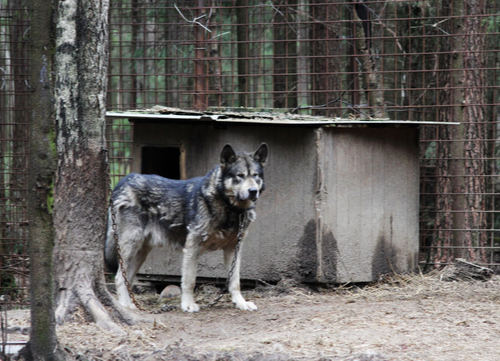
Hybrid Wolfdog – 85 attacks and 19 kills
It does not appear as PDD because the Hybrid Wolfdog is hardly present in the United States. Even so, it ranks in the U.S. statistics on dog bites.
Its attacks are justified by its marked predatory character, that is to say, of preying. The crossing of a wolf with another dog, hence the name hybrid wolf, still maintains a strong instinctive character. The great majority of their attacks were made on children, who with their games, it is all too easy to awaken in them their wildest instincts.

Siberian Husky – 83 attacks and 26 kills
It does not appear in the PDD list. The attacks carried out by these Huskies are registered as semi-wild animals. These attacks were carried out in very cold, desert areas, as they spent a lot of time alone and isolated, so the lack of socialization and habituation with other humans prompted the attacks.

Akita – 70 attacks and 8 deaths
It does appear on the PDD list. Most attacks were on children and in their own home. The Akita falls in the middle of the pack in U.S. statistics on dog bites.
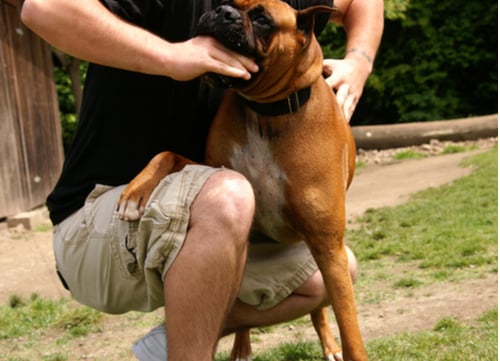
Boxer – 64 attacks and 7 kills
It does not appear on the PDD list, it is a very popular breed and famous for being very affectionate with children, however, 19 of them were its victims. Once again, the lack of knowledge when it comes to reading the warning signs and the lack of education causes these dogs to attack.
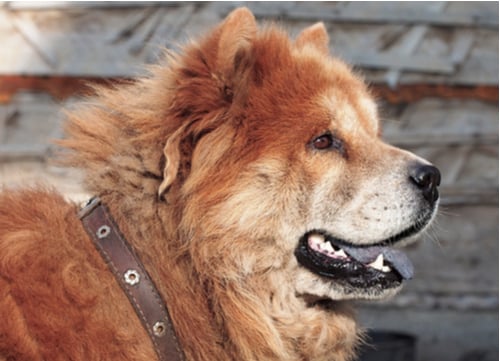
Chow Chow – 61 attacks and 8 deaths
It does not appear on the potentially dangerous dogs list and the vast majority of its attacks were on children. When considering the U.S. statistics on dog bites, the Chow Chow is not a breed that is very tolerant of children as it is very independent and does not like rough play.

Labrador Retriever – 56 attacks and 3 deaths
Surprisingly, the most popular breed of all and the one considered most family friendly is not free from being a dangerous dog either. Probably higher on the U.S. statistics on dog bites than you thought. It's usually not the animal's fault!
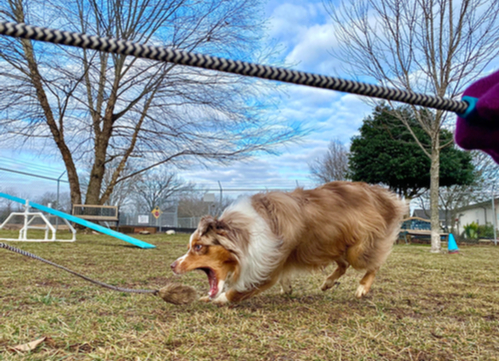
Australian Shepherd – 38 attacks and 1 death
Also not on the PDD list. Like the German Shepherd, its instinct to protect and guard can lead to attack without meaning harm.

Great Dane – 37 attacks and 3 kills
Not on the PDD list and considered one of the calmest breeds, so once again, lack of knowledge about canine psychology prompts these totally avoidable attacks.

Mastiff – 28 attacks and 5 deaths
Does not appear on the PDD list. With their great strength and powerful body, even if not intended, calculating the force of the bite may be the reason for unfortunate incidents.
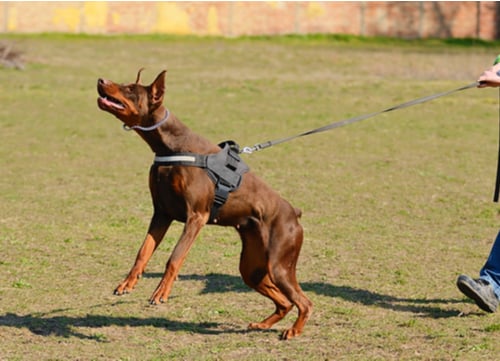
Doberman – 23 attacks and 8 kills
Does not appear on the PDD list. In the 80's the Doberman was demonized and even urban legends were created about the disproportionate growth of their brains that drove them crazy and provoked moral attacks on people. Nothing could be further from the truth. The reality is that we humans are to blame for not knowing how to educate them and meet their demands.
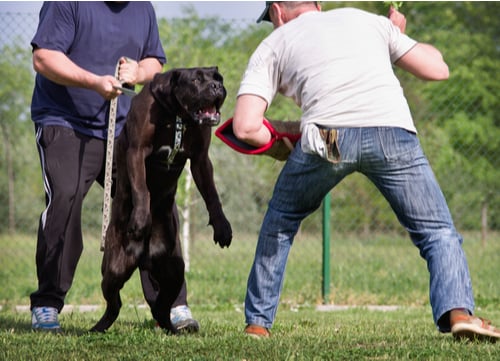
Cane Corso – 21 attacks and 2 deaths
It does not appear in the PDD list. As in previous occasions, we do not know how to read their alarm signals. This makes it one of the breeds in U.S. statistics on dog bites, that reading body language doesn't always work.

English Bulldog – 20 attacks and 1 kill
What? The English Bulldog? With that good-natured face? Well, it is an example that we are failing our friends when they tend to attack us. In this case, such a calm and serene dog has been responsible for the vast majority of attacks on children.

Alaskan Malamute – 15 attacks and 6 kills
Also does not appear in the PDD list. Majority of its attacks, unlike the Huskies, have been inside the home and on the youngest members of the household.

St. Bernards – 12 attacks and 1 kill
Not on the PDD list. This good-natured dog also loses patience with the little ones in the house.
 Golden Retriever – 11 attacks and 3 kills
Golden Retriever – 11 attacks and 3 kills
Like the Labrador, it is one of the most popular dogs and has a very good reputation with children, however, it is not free from attacking when several factors come together. Although it isn't on the PDD (Potentially Dangerous Dogs) list.
FINAL THOUGHTS/CONCLUSION
Now that you have an understanding of U.S. Statistics on Dog Bites, you know better. As much as dog bites occur, they are not as regular as you think they are. As a matter of fact, they happen on rare occasions.
Yes, it is true that there are breeds that are more aggressive than others but as we explained the dog bites are beyond the bites. The bites could be from their history and behavior and without adequate knowledge, your mannerisms may be misunderstood as dangers to them. So while some dogs may be aggressive, it shouldn’t make you fearful of the entire breed.
Read Next: 20 Most Dangerous Dogs in the World














